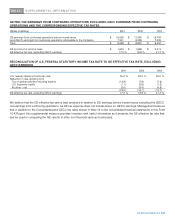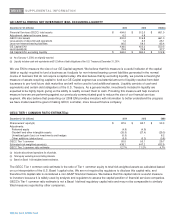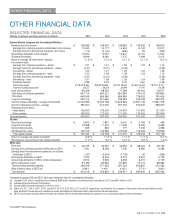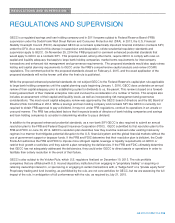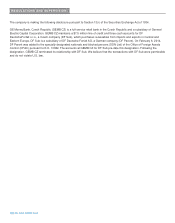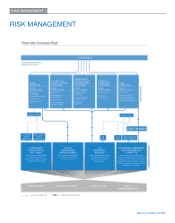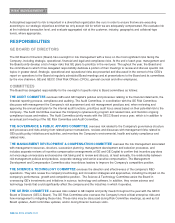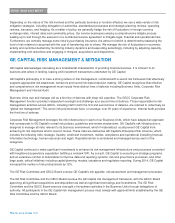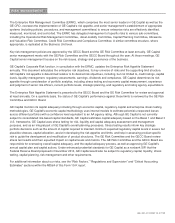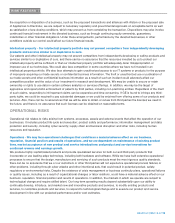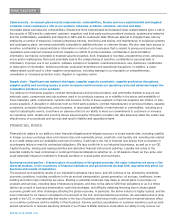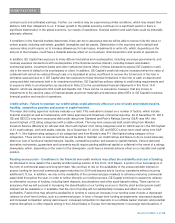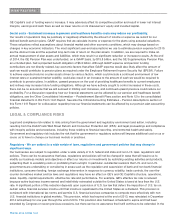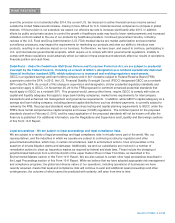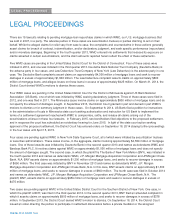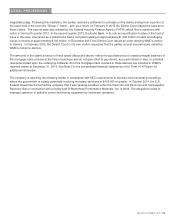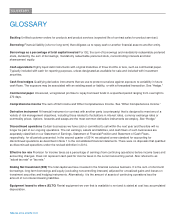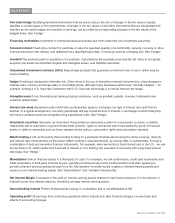GE 2014 Annual Report Download - page 131
Download and view the complete annual report
Please find page 131 of the 2014 GE annual report below. You can navigate through the pages in the report by either clicking on the pages listed below, or by using the keyword search tool below to find specific information within the annual report.
GE 2014 FORM 10-K 111
RISK MANAGEMENT
The Enterprise Risk Management Committee (ERMC), which comprises the most senior leaders in GE Capital as well as the
GE CRO, oversees the implementation of GE Capital’s risk appetite, and senior management’s establishment of appropriate
systems (including policies, procedures, and management committees) to ensure enterprise risks are effectively identified,
measured, monitored, and controlled. The ERMC has delegated management of specific risks to various sub-committees,
including the Operational Risk Management Committee, Asset-Liability Committee, Capital Planning Committee, Allowance
and Valuation Risk Committee, Credit Risk Committee and Compliance Committee. A similar committee structure, where
appropriate, is replicated at the Business Unit level.
Key risk management policies are approved by the GECC Board and the GE Risk Committee at least annually. GE Capital
senior management meets with the GE Risk Committee and the GECC Board throughout the year. At these meetings, GE
Capital senior management focuses on the risk issues, strategy and governance of the business.
GE Capital’s Corporate Risk function, in consultation with the ERMC, updates the Enterprise Risk Appetite Statement
annually. This document articulates the enterprise risk objectives, its key universe of risks and the supporting limit structure.
GE Capital’s risk appetite is determined relative to its desired risk objectives, including, but not limited to, credit ratings, capital
levels, liquidity management, regulatory assessments, earnings, dividends and compliance. GE Capital determines its risk
appetite through consideration of portfolio analytics, including stress testing and economic capital measurement, experience
and judgment of senior risk officers, current portfolio levels, strategic planning, and regulatory and rating agency expectations.
The Enterprise Risk Appetite Statement is presented to the GECC Board and the GE Risk Committee for review and approval
at least annually. On a quarterly basis, the status of GE Capital’s performance against these limits is reviewed by the GE Risk
Committee and GECC Board.
GE Capital monitors its capital adequacy including through economic capital, regulatory capital and enterprise stress testing
methodologies. GE Capital’s economic capital methodology uses internal models to estimate potential unexpected losses
across different portfolios with a confidence level equivalent to an AA agency rating. Although GE Capital is not currently
subject to consolidated risk-based capital standards, GE Capital estimates capital adequacy based on the Basel 1 and Basel 3
U.S. frameworks. GE Capital uses stress testing for risk, liquidity and capital adequacy assessment and management
purposes, and as an integral part of GE Capital’s overall planning processes. Stress testing results inform key strategic
portfolio decisions such as the amount of capital required to maintain minimum expected regulatory capital levels in severe but
plausible stresses, capital allocation, assist in developing the risk appetite and limits, and help in assessing product specific
risk to guide the development and modification of product structures. The GE Risk Committee and the GECC Board review
stress test results and their expected impact on capital levels and metrics. The GE Risk Committee and the GECC Board are
responsible for overseeing overall capital adequacy, and the capital adequacy process, as well as approving GE Capital’s
annual capital plan and capital actions. Under enhanced prudential standards for GE Capital as a nonbank SIFI that the
Federal Reserve Board proposed in November 2014, GE Capital would also be subject to regulatory capital, liquidity, stress
testing, capital planning, risk management and other requirements.
For additional information about our risks, see the “Risk Factors,” “Regulations and Supervision” and “Critical Accounting
Estimates” sections within the MD&A of this Form 10-K report.


